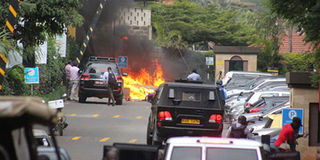Those beasts terrorising our lives must be stopped every which way

The scene of a terror attack at DusitD2 hotel on January 15, 2019. PHOTO | FILE | NATION MEDIA GROUP
What you need to know:
- Seven APs died when their vehicle hit an improvised explosive device planted on the road near the Konton area.
- According to reports, last year alone, more than 100 security officers lost their lives in similar attacks.
- As a country, we failed to recognise and deal with the causes of radicalisation among youth until it was almost too late.
Exactly one week ago today, nine Administration Police officers boarded a vehicle in Wajir County, to go in pursuit of terrorists from Somalia who had a day earlier killed a police reservist and abducted two others.
Seven of those APs died when their vehicle hit an improvised explosive device planted on the road near the Konton area, while two others went missing. The Somalia-based terrorist group, Al-Shabaab, later gloated it was responsible for the atrocity.
AMBUSH
Apparently, this was a well-planned and well-executed ambush, giving the impression that the terrorists either knew how the officers would react, or they had prior intelligence about the mission and when the APs would arrive at that exact spot.
This latter would mean that from the word go, the APs were sitting ducks, which is a terrifying thought.
It also clearly indicates that Kenya is no nearer to winning the war against terror than it has ever been.
To be sure, although IED-based strikes are not as dramatic as those that claim tens of lives at a go, a war of attrition is ultimately more deadly than pitched combat and a lot more dispiriting for those charged with defending Kenya.
At least in conventional warfare, the defenders know where the enemy is, but due to the asymmetrical nature of terrorist attacks, there can never really be a declaration of victory by any of the parties involved.
SECURITY
This was not the first time Kenya’s security personnel have fallen while protecting their country and it is not likely to be the last.
According to reports, last year alone, more than 100 security officers, mainly policemen, lost their lives in similar attacks in the vast territory close to the Kenya-Somalia border. In fact, the August of that year was the worst when more than 35 security personnel were killed by IEDs on five different occasions.
The only conclusion is that the militants have changed tactics, no doubt because our counter-terrorism efforts have been working since last year. They can no longer easily engage in the kind of wanton killings that characterised the Westgate and Garissa University College attacks.
But that does not mean that the cost in lives is any easier to take. The fact that the terrorists can still attack targets like the DusitD2 complex indicates that they have settled on a three-pronged strategy, switching from grand-bang carnage, to dire hostage situations, and then to isolated roadside bombings, often in the same month.
TERRORISM
This also means that our multi-disciplinary counter-terrorism strategies must keep changing with the times.
The only way to defeat these people is to stay ahead, out-think them and pre-empt them. So far, our counter-terrorism warriors have been doing a commendable job, which is why fewer Kenyans are dying from these dastardly attacks than ever before, but we are not likely to be out of the woods any time soon.
We as a country failed to recognise and deal with the causes of radicalisation among youth until it was almost too late.
A brief look at the history of the major al-Shabaab attacks may help in terms of setting the right perspective.
In the last 39 years, Kenya has suffered at least six major terrorist attacks. The first was in 1980 when the Norfolk Hotel was bombed with a loss of 20 lives. By then, neither Al-Shabaab nor Al Qaeda were in existence; the terrorists who targeted the hotel were Palestinian organisations in retaliation for the help Kenya had given the Israelis during the Entebbe raid four years earlier.
DAMAGE
The American embassy bombing of 1998 was the deadliest in Kenya’s history: 213 people were killed, 211 of them Kenyans. Needless to say, the primary targets were Americans, and the Kenyans who perished were mere collateral damage.
This gave prominence to Osama bin Laden’s Al Qaeda, which was also to claim responsibility for the Kikambala Hotel bombing in 2002 aimed at Israeli tourists during which again, Kenyans were the majority victims.
However, the terrorist attack that is still fresh in Kenyans’ minds was that of the Westgate Mall in Nairobi carried out by al-Shabaab terrorists on September 21, 2013.
Due to bumbling incompetence by our security forces during a siege that lasted four days, 71 people, both local and foreign, died.
This attack was a turning point in the way to handle a terrorist siege. However, apparently, some lessons were missed as was to be demonstrated during a similar attack at Garissa University College two years later.
MASSACRES
This attack by al-Shabaab was far deadlier with 150 casualties reported, all of them Kenyan non-Muslim students.
Kenyans have borne the brunt of massacres perpetrated by terrorists affiliated to either al-Qaeda or al-Shabaab on one pretext or the other.
Their latest justification is the presence of the Kenya Defence Forces in Somalia since 2011.
The only thing we can do is to protect our security officers out in the field as much as possible. No other soldier or policeman should be killed by roadside bombs. I know this is simplistic, but surely there must be ways of sniffing out and dismantling those things before they explode.
Mr Ngwiri is a consultant editor; [email protected]





